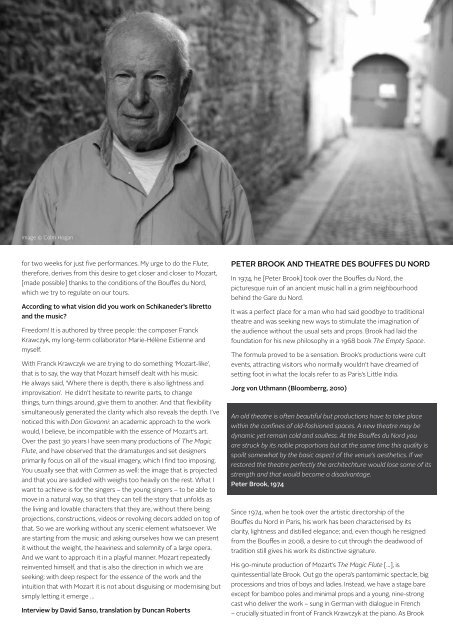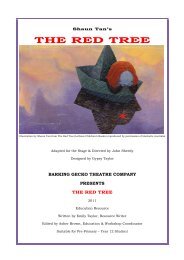Create successful ePaper yourself
Turn your PDF publications into a flip-book with our unique Google optimized e-Paper software.
Image © Colm Hogan<br />
for two weeks for just five performances. My urge to do the Flute;<br />
therefore, derives from this desire to get closer and closer to Mozart,<br />
[made possible] thanks to the conditions of the Bouffes du Nord,<br />
which we try to regulate on our tours.<br />
According to what vision did you work on schikaneder’s libretto<br />
and the music?<br />
Freedom! It is authored by three people: the composer Franck<br />
Krawczyk, my long-term collaborator Marie-Hélène Estienne and<br />
myself.<br />
With Franck Krawczyk we are trying to do something ‘Mozart-like’,<br />
that is to say, the way that Mozart himself dealt with his music.<br />
He always said, ‘Where there is depth, there is also lightness and<br />
improvisation’. He didn’t hesitate to rewrite parts, to change<br />
things, turn things around, give them to another. And that flexibility<br />
simultaneously generated the clarity which also reveals the depth. I’ve<br />
noticed this with Don Giovanni: an academic approach to the work<br />
would, I believe, be incompatible with the essence of Mozart’s art.<br />
Over the past 30 years I have seen many productions of The Magic<br />
Flute, and have observed that the dramaturges and set designers<br />
primarily focus on all of the visual imagery, which I find too imposing.<br />
You usually see that with Carmen as well: the image that is projected<br />
and that you are saddled with weighs too heavily on the rest. What I<br />
want to achieve is for the singers – the young singers – to be able to<br />
move in a natural way, so that they can tell the story that unfolds as<br />
the living and lovable characters that they are, without there being<br />
projections, constructions, videos or revolving decors added on top of<br />
that. So we are working without any scenic element whatsoever. We<br />
are starting from the music and asking ourselves how we can present<br />
it without the weight, the heaviness and solemnity of a large opera.<br />
And we want to approach it in a playful manner. Mozart repeatedly<br />
reinvented himself, and that is also the direction in which we are<br />
seeking: with deep respect for the essence of the work and the<br />
intuition that with Mozart it is not about disguising or modernising but<br />
simply letting it emerge …<br />
interview by david sanso, translation by duncan roberts<br />
PeTer BrooK And THeATre des BouFFes du nord<br />
In 1974, he [Peter Brook] took over the Bouffes du Nord, the<br />
picturesque ruin of an ancient music hall in a grim neighbourhood<br />
behind the Gare du Nord.<br />
It was a perfect place for a man who had said goodbye to traditional<br />
theatre and was seeking new ways to stimulate the imagination of<br />
the audience without the usual sets and props. Brook had laid the<br />
foundation for his new philosophy in a 1968 book The Empty Space.<br />
The formula proved to be a sensation. Brook’s productions were cult<br />
events, attracting visitors who normally wouldn’t have dreamed of<br />
setting foot in what the locals refer to as Paris’s Little India.<br />
Jorg von uthmann (Bloomberrg, 2010)<br />
An old theatre is often beautiful but productions have to take place<br />
within the confines of old-fashioned spaces. A new theatre may be<br />
dynamic yet remain cold and soulless. At the Bouffes du Nord you<br />
are struck by its noble proportions but at the same time this quality is<br />
spoilt somewhat by the basic aspect of the venue’s aesthetics. If we<br />
restored the theatre perfectly the architechture would lose some of its<br />
strength and that would become a disadvantage.<br />
Peter Brook, 1974<br />
Since 1974, when he took over the artistic directorship of the<br />
Bouffes du Nord in Paris, his work has been characterised by its<br />
clarity, lightness and distilled elegance; and, even though he resigned<br />
from the Bouffes in 2008, a desire to cut through the deadwood of<br />
tradition still gives his work its distinctive signature.<br />
His 90-minute production of Mozart’s The Magic Flute […], is<br />
quintessential late Brook. Out go the opera’s pantomimic spectacle, big<br />
processions and trios of boys and ladies. Instead, we have a stage bare<br />
except for bamboo poles and minimal props and a young, nine-strong<br />
cast who deliver the work – sung in German with dialogue in French<br />
– crucially situated in front of Franck Krawczyk at the piano. As Brook





